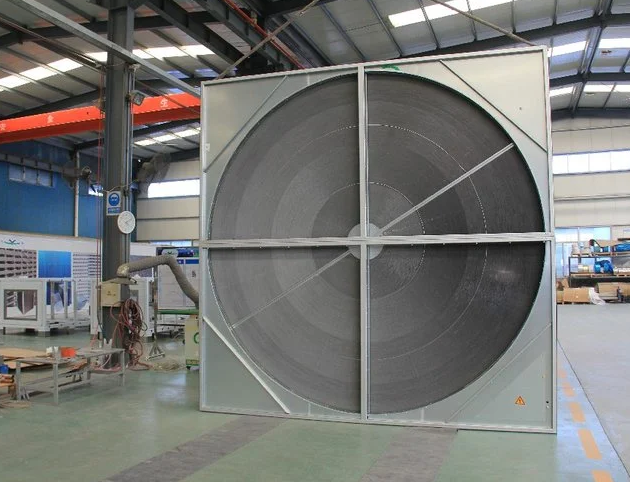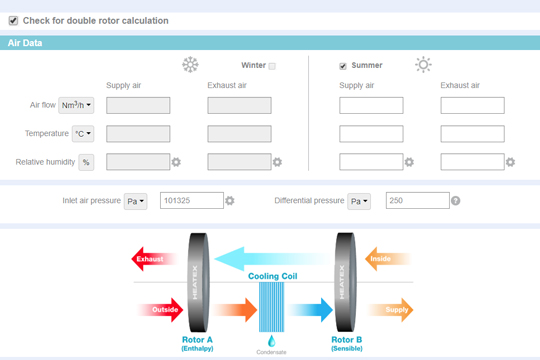A coating machine is a mechanical device used to evenly apply specific functional adhesives, coatings, inks, etc. onto the surface of a substrate and dry it, with a wide range of applications. For example, printing and packaging coating, textile and building materials anti-corrosion and waterproof coating, automotive sheet metal coating, optical coating for circuit boards, semiconductors, and lithium battery production coating.
The coating process of a coating machine mainly includes three steps: coating, drying, and winding. The drying process generates a large amount of waste heat during the heating process. Therefore, designing an effective waste heat recovery device can effectively reduce the energy consumption of the coating machine, which is important for its energy conservation and environmental protection.
Principle of residual heat recovery of coating machine
The waste heat recovery device of the coating machine uses a heat exchanger to recover waste heat. Using the waste heat gas emitted by the coating machine (coating machine) to preheat the new air, the preheated new air enters the oven through the pipeline, achieving the goal of energy conservation. The heat exchanger achieves waste heat recovery by exchanging heat between the hot air and flue gas generated during the drying process of the coating machine and the recovery medium (such as air, water, or other fluids). Hot air and flue gas flow through the heat exchanger through one side channel, while the recovery medium flows through the other side channel. The plate structure of the heat exchanger increases the surface area for heat transfer and improves the efficiency of heat recovery.
Advantages of Coating Machine Waste Heat Recovery Device
Compact structure, high heat transfer efficiency, and strong adaptability. They are suitable for heat transfer and energy recovery in high temperature, high humidity, and corrosive environments. Through a well-designed waste heat recovery system, lithium battery coating machines can operate more efficiently and reduce their impact on the environment.
Coating machine, heating shaping machine, tunnel furnace exhaust gas heat recovery device
Wood drying waste heat recovery plate heat exchanger
In the conventional drying process of wood, the traditional ventilation method results in significant heat loss due to the removal of moisture and exhaust gas. The forced ventilation and waste heat recovery system in the wood drying room is a new technology that improves the indoor and outdoor dry wet air exchange process in drying production and effectively recovers waste heat.
The counterflow plate heat exchanger adopts high-quality hydrophilic coated aluminum foil, epoxy resin coated aluminum foil and other materials. The two air streams enter the channel in reverse, increasing the heat transfer area. The fresh air and exhaust air are completely separated to avoid the transmission of odors and moisture. Fast thermal conductivity, no secondary pollution, achieving ventilation and heat recovery functions.
Plate heat exchanger, heat pump, drying heat exchanger, industrial fresh air fan, heat recovery equipment
Product Introduction:
Plate heat exchanger is a detachable energy recovery heat exchange device composed of multiple corrugated heat transfer plates. The heat exchange core is made of hydrophilic aluminum foil, oxygen resin aluminum foil, stainless steel and other materials. The air flows in a cross flow manner, and the fresh exhaust is completely separated to avoid the transmission of any odor and moisture.
Product features:
- Using hydrophilic coated aluminum foil as the heat transfer conductor, processed by special technology, it has the characteristics of high heat transfer efficiency, easy maintenance, and long service life.
- Epoxy resin aluminum foil can be used, which is corrosion-resistant and suitable for special occasions.
- Multiple specifications, sizes, and spacing (3-12mm) are available for selection.
- Modular structure, capable of providing combinations of cross-sections of any size and plate stacking thickness, with no moving parts and low equipment maintenance costs.
- Compact structure, small volume, suitable for various occasions.
- Flexible assembly: The combination form of plate heat exchangers can be reasonably selected according to the size of the usage and installation site space, as well as the operating conditions.
Application areas:
Widely used in ventilation, energy recovery, cooling, heating, dehumidification, and waste heat recovery industries such as HVAC, telecommunications, power, textile, automotive, food, medical, agriculture, animal husbandry, baking, drying, welding, and boilers.
Heat pump system: Plate heat exchangers are widely used in air source heat pump systems, suitable for household and small commercial projects.
Industrial sector: Suitable for large-scale heat exchange in industrial production, such as chemical, food processing, energy and power industries.
Ground source heat pump system: suitable for ground source heat pump systems, with high heat transfer efficiency.
Seawater desalination: suitable for seawater desalination process, corrosion-resistant and high-temperature resistant.
DATA CENTER COOLING EXCHANGERS
The application of cooling heat exchangers in data centers is an important component of energy efficiency management in data centers. Through efficient thermal management technology, energy consumption is significantly reduced and system performance is improved.

The function of plate heat exchanger
Improving energy efficiency: Plate heat exchangers play a crucial role in data center cooling systems. Through an efficient heat exchange process, plate heat exchangers can effectively transfer the heat generated by servers to the cooling water, which is then released into the atmosphere through the cooling tower. This efficient heat exchange process not only improves the energy efficiency of data centers, but also reduces energy consumption and operating costs.
Optimize temperature control: Plate heat exchangers can accurately control the temperature and humidity inside data centers, ensuring that server equipment operates in a suitable environment. By adjusting the flow rate and temperature of cooling water, plate heat exchangers can meet the cooling needs of different data centers, ensuring the stable operation and efficient performance of server equipment.
Energy saving and environmental protection: The use of plate heat exchangers helps reduce the impact of data centers on the environment. By using environmentally friendly materials and energy-saving technologies, plate heat exchangers can reduce energy consumption and emissions, in line with the concept of sustainable development. Meanwhile, the efficient heat exchange process of plate heat exchangers also reduces waste of natural resources, providing strong support for the green operation of data centers.
Flexible and reliable: Plate heat exchangers have the advantages of compact structure, small footprint, and easy installation, making them widely used in space limited places such as data centers. At the same time, the design and manufacturing of plate heat exchangers have undergone strict quality control and testing verification, ensuring their long-term stable and reliable operational performance.
Rotary air to air heat recovery exchanger
Rotary heat exchanger, an industrial energy-saving tool, adopts advanced design, dynamically adapts to changes in heat load, and improves heat transfer efficiency and thermal energy utilization. It efficiently converts heat energy through two methods: direct contact heat transfer and indirect heat transfer. Compared with fixed bed heat exchangers, it has higher heat transfer efficiency and larger heat transfer area, especially in high temperature, high pressure, and high corrosion environments, demonstrating unique advantages. High degree of automation, reducing labor costs, and achieving precise temperature control. Widely used in industries such as petrochemicals, energy and power, food and medicine, as heaters, coolers, condensers and other equipment, to improve energy utilization efficiency, reduce energy consumption and carbon emissions.

Summary of Characteristics:
High heat transfer efficiency: dynamic operation to enhance efficiency.
Strong adaptability: able to handle diverse processes and meet complex needs.
High degree of automation: advanced control, reducing costs.
Easy to maintain: The structure is simple, easy to maintain, and cost-effective.
Heat recovery for livestock and poultry houses: plate heat exchangers or rotary heat exchangers
The heat recovery products used in livestock and poultry houses mainly recover the heat energy in the exhaust through the principle of heat exchange and use it to preheat the fresh air entering the house. This not only ensures the minimum ventilation required in winter, but also reduces the heating energy consumption inside the building. This technology usually uses heat recovery ventilation equipment, such as plate heat exchangers or rotary heat exchangers, which can effectively capture the heat in the exhaust while ensuring the quality of the fresh air supply.
The main advantages include:
Reduce energy consumption: By recovering heat, the use of external heating equipment is reduced, significantly lowering energy costs.
Ensure air quality: Although heat recovery is carried out, it will not affect the circulation of air in the house, and the minimum ventilation rate can still be ensured to maintain the air quality in the livestock and poultry house.
Improving comfort: Preheating fresh air helps maintain a suitable temperature inside the house, reduce stress reactions in livestock and poultry, and improve production efficiency.
This technology is particularly important in cold winter regions as it can significantly reduce heating energy consumption while providing a healthy living environment for livestock and poultry.
Fresh air ventilator with waste heat recovery, primary efficiency, medium efficiency, high-efficiency air filters
Fresh air ventilator with waste heat recovery, primary efficiency, medium efficiency, high-efficiency air filters, customized production by the manufacturer

How a Double Rotor Setup Works
1. The enthalpy/adsorption rotor dehumidifies and cools the hot and humid outside air.
2. The cooling coil further dehumidifies the outside air until the requested humidity level is reached.
3. The sensible rotor reheats the outside air to the required supply air temperature.
4. At the same time, the exhaust air is cooled which increases the efficiency of the enthalpy/adsorption rotor.

How does a rotary heat exchanger work?
The wheel is built up by a matrix that consists of two foils, one flat and one corugated;together, they create channels for the air to pass through. The wheel is rotated by an electricmotor and belt drive system.
In one half of the rotation, the exhaust air from the inside space flows through the matrix. ltsheat is stored in the matrix, and in the other half of the rotation, it is transferred to the freshsupply air from outside.
The size of the channel is called well height. Different well heights and diameters of thewheel give different efficiencies, pressure drops, and airflow rates.
Rotary heat exchangers that are properly constructed, installed, and maintained have almostzero transfer of particle-bound pollutants.

Principle of rotary heat recovery fresh air unit
The main component of the rotary heat recovery fresh air unit is a disc-shaped heat storage wheel, which is made of aluminum foil wound into a honeycomb shape as the heat storage body. During operation, fresh air passes through one half circle of the heat exchanger, while exhaust air flows in the opposite direction through the other half circle. The heat storage wheel rotates continuously at a speed of about 10 revolutions per minute under the action of the power mechanism, and the heat storage body is constantly heated on the high-temperature half circle side, absorbing heat; When rotating to the low-temperature semicircle side, it is cooled and releases heat. This process repeats itself, recovering some of the energy (cold and heat) from the exhaust air into the fresh air. A moisture absorbing material is coated on the surface of the aluminum foil to create a fully heated rotor. The moisture in the airflow enters the moisture absorbing coating and is released when the rotor reaches another airflow. The composition of the rotor type heat recovery fresh air fan is to use the exchange of sensible and latent heat between the fresh air and exhaust air to recover energy, achieving energy conservation and maintaining good ventilation. In summer, the fresh air can be pre cooled and dehumidified, and in winter, it can be preheated and humidified.
